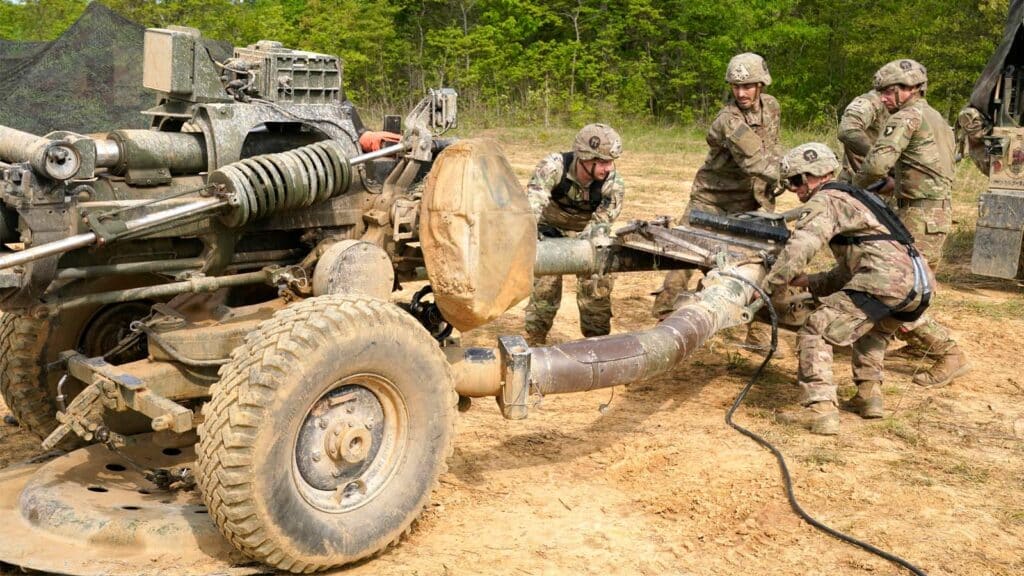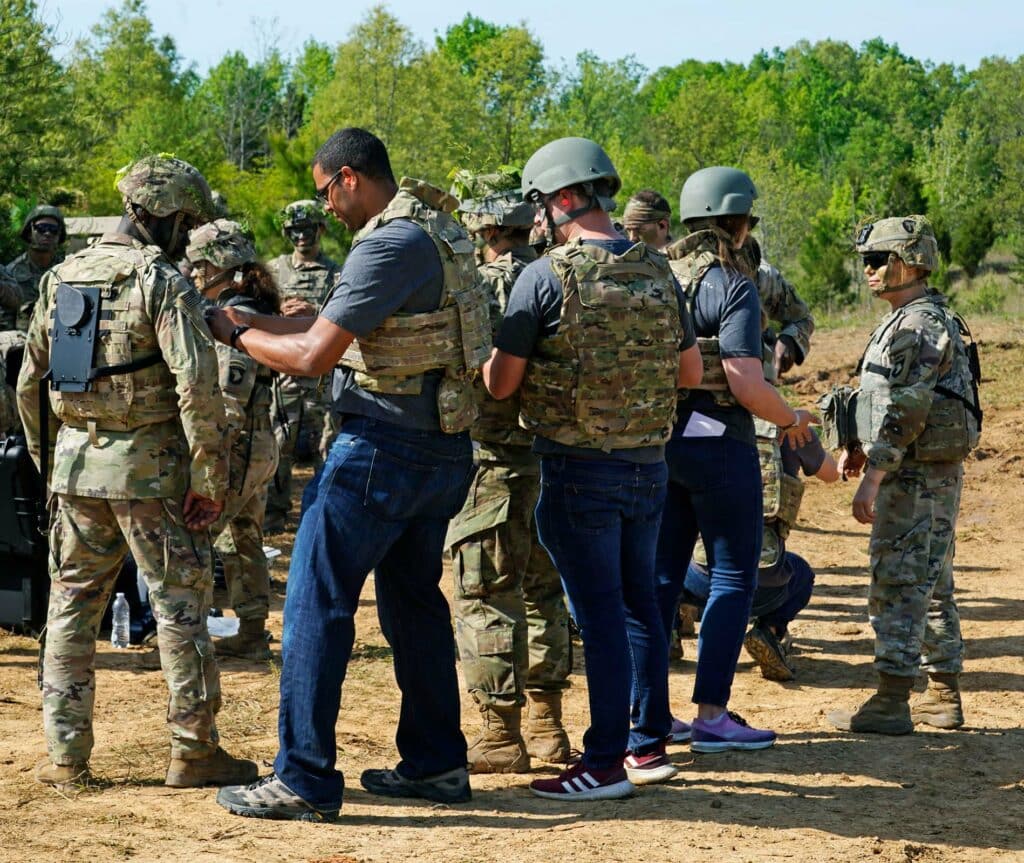This article was originally posted on Forbes.com (link) on August 16, 2022.
A passive exoskeleton model designed and evaluated with the help of over 100 Soldiers at three Army posts completed field testing in May 2022 with high approval. The wearable device is called the Soldier Assistive Bionic Exosuit for Resupply (SABER). As a result of the successful field testing, DEVCOM will provide funding to HeroWear, a Nashville-based industrial exoskeleton company, and Vanderbilt University to revise the design and deliver dozens of pre-production units to the Army by the end of 2022 in preparation for mass production and additional field testing.
SABER Will Not Turn Soldiers Into Iron Man
Unlike many previous attempts at creating military exoskeletons, SABER will not turn people into superheroes. The wearable will not bounce bullets, give the ability to fly, or allow dismounted Soldiers to travel with more gear. Instead, SABER is an unpowered wearable exosuit with no actuators or motors. This exoskeleton (exosuit is a categorization of exoskeleton like a sedan is a subcategory of an automobile) takes advantage of elastic elements to offload some of the forces from the back and spine of Soldiers. The SABER is meant to assist with lifting and reduce back strain during logistics operations.
Safeguarding Soldiers
Low back injuries lead to more than one million lost or limited duty days for Soldiers each year, reports the U.S. Army Public Health Center. This is the equivalent of over 460 back overuse injuries every day, including on weekends (U.S. Army Injury Surveillance 2019 Summary).
A similar study demonstrated that of 57 potential risk factors, load carriage and high training dosage were the two leading, most related risk factors to an injury outside combat (link). The authors conclude that “musculoskeletal injuries are a leading cause of health care utilization, as well as limited duty and disability in the U.S. military and other armed forces. They affect members of the military during initial training, operational training, and deployment and have a direct negative impact on overall troop readiness.”
The Solution
Exoskeletons and exosuits can be a practical solution to reducing Soldier injuries during logistical tasks. They are different from most wearables that are making their way into warehouses which inform the user when they are overexerting themselves. Instead, exoskeletons are placed between one or more joints of the human body and create a physical bridge that can be used to empower or resist the motion of the user. In the case of the SABER, the exosuit is designed to physically offload some of the strain on the back muscles using elastic straps that run parallel to the body. The exosuit can be disengaged at any time by the user without having to be removed. SABER does physical work together with the Soldiers, minimizing the risk of lower back injury while performing their tasks.

One way to imagine the goals of exoskeletons is to go back to the introduction of power steering. During the Second World War, the wheels of logistical vehicles and trucks would regularly get stuck in mud or dirt roads. Power steering was a solution to get logistical tasks completed reliably. It didn’t increase the amount of cargo that drivers were expected to deliver, nor did it make their arms weaker by having a device that helped them turn the steering wheel. The same goals apply to all military exoskeleton devices.
Involving Soldiers in the Design Phase
Soldiers from the 101st Airborne Division at Fort Campbell were heavily involved with the team from Vanderbilt in the design and testing of the SABER exoskeleton. In a year, over 100 soldiers from Fort Campbell, Fort Still, and Fort Knox participated in the design and testing of the exosuit. The work is part of the Army’s Pathfinder Program. The Pathfinder program is a Congressional initiative to advance the Army Futures Command’s modernization goals. It is focused on supporting the innovation of Solder-inspired and research-based technologies. DEVCOM leverages the program to connect Soldiers with science and technology networks. This project is a testament to the potential for success by including users early in the design and testing process.

“We spent the first few months focused on interviewing, observing and spending time with Soldiers,” said Dr. Karl Zelik, associate professor of mechanical engineering, Vanderbilt University. “We didn’t try to create Iron Man—a complex, full-body, rigid, unrealistic suit. Instead, we started by deeply understanding Soldier needs to develop a lightweight, low-profile, non-powered wearable tool that helps provide much-needed assistance without slowing Soldiers down or interfering with other operational tasks.”
Field Testing and Next Steps
More than 100 Soldiers have participated in the testing of the exosuit. Of those involved with field testing, 90% reported the exosuit increased their ability to perform their tasks and would likely wear the SABER if it was made available. “Over the course of the day, lifting 60-pound rounds you get worn out, especially after hours. It takes a toll on your body…,” said Private First Class Dale Paulson, 101st Airborne Division, 3-320th Field Artillery, Cannoneer, 13B. “Wearing the suit really helped a lot, especially with getting the rounds out of the back of the truck… It felt like it gave me an extra boost. I didn’t have to work as hard… I feel like it helped me move quicker.”
SABER will move from the Pathfinder Program to the U.S. Army Combat Capabilities Development Command, (DEVCOM). DEVCOM will provide funding to Vanderbilt University and HeroWear, to prepare the exosuit for manufacturing and field use.
“We were extremely proud to be recognized by our fellow DEVCOM and AFC leads as partners of choice in understanding the technology, and how to introduce this game-changing capability to Soldiers,” said Dave Audet, chief, systems division, DEVCOM SC. “Our on-going DEVCOM Soldier Center exoskeleton program and collaboration with Vanderbilt made it possible to accelerate technology modification and a successful transition from ARL to Soldier Center.”
By involving Soldiers early in its design, the SABER has become a separate product from the civilian exosuits already offered by HeroWear. “At HeroWear we are developing a suite of assistive solutions that reduce fatigue and physical strain on workers. The Apex remains our flagship back-assist suit for civilian workers in logistics and manufacturing,” said Mark Harris, CEO of HeroWear. “With ongoing support from the Army, we’re now excited to be adding this SABER suit as a new product line. The SABER suit will meet the unique needs of U.S. Army Soldiers, and will integrate with their gear. We also expect that some of the exosuit innovations developed for Soldiers will end up benefiting civilian workers in future HeroWear products.”
This is a major step for the entire exoskeleton industry that can lead to a transformation in how wearable technology for physical augmentation is viewed around the globe.
References and additional reading:
- Original post on Forbers.com: (link), Aug 16, 2022
- Army, academia collaborate on exoskeleton to reduce Soldier injuries, DEVCOM Public Affairs Office, Aug 17, 2022, link
-
Vanderbilt, 101st Airborne collaborate on development of exoskeleton for soldier use in inaugural Pathfinder Project, Vanderbilt University Research News, Aug 17, 2022, link








Add Comment